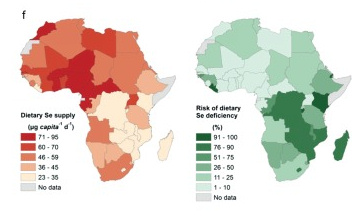Dietary micronutrient deficiencies (MNDs) are widespread, yet their prevalence can be difficult to assess. Here, we estimate MND risks due to inadequate intakes for seven minerals in Africa using food supply and composition data, and consider the potential of food-based and agricultural interventions. Food Balance Sheets (FBSs) for 46 countries were integrated with food composition data to estimate per capita supply of calcium (Ca), copper (Cu), iron (Fe), iodine (I), magnesium (Mg), selenium (Se) and zinc (Zn), and also phytate. Deficiency risks were quantified using an estimated average requirement (EAR) ‘cut-point’ approach. Deficiency risks are highest for Ca (54% of the population), followed by Zn (40%), Se (28%) and I (19%, after accounting for iodized salt consumption). The risk of Cu (1%) and Mg (<1%) deficiency are low. Deficiency risks are generally lower in the north and west of Africa. Multiple MND risks are high in many countries. The population-weighted mean phytate supply is 2770 mg capita−1 day−1. Deficiency risks for Fe are lower than expected (5%). However, ‘cut-point’ approaches for Fe are sensitive to assumptions regarding requirements; e.g. estimates of Fe deficiency risks are 43% under very low bioavailability scenarios consistent with high-phytate, low-animal protein diets. Fertilization and breeding strategies could greatly reduce certain MNDs. For example, meeting harvestplus breeding targets for Zn would reduce dietary Zn deficiency risk by 90% based on supply data. Dietary diversification or direct fortification is likely to be needed to address Ca deficiency risks.
See full size Dietary Map of African mineral deficiencies

